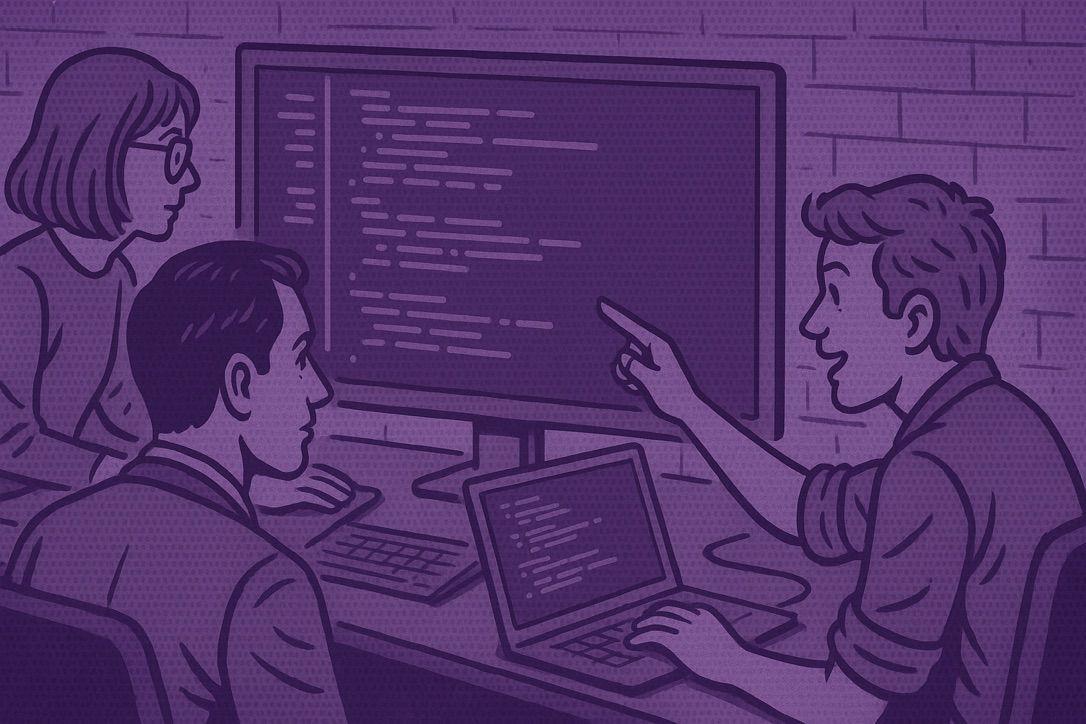- STAFF AUGMENTATION
- SAAS
Staff Augmentation for SaaS Companies
Nov 24, 2025
-
Emilia Skonieczna
-
7 minutes

In the SaaS environment, development speed and team flexibility matter more than ever - and this is why staff augmentation is especially valuable.
It's a model full of advantages, from avoiding idle time costs to gaining on-demand access to specialized skills. But just like any solution, it comes with challenges too.
Staff augmentation may sound a bit unusual at first - almost like "selling people". But it's simply the practice of sharing available specialists with teams that need them, exactly when they need them.
Instead of keeping talent on the bench, you allow experts to support another company for a defined period of time.
Staff augmentation is a resourcing model that gives companies temporary access to specialists they need while still maintaining full control over the project.
But how does it actually work?
If a team needs a specific expert for a project - but doesn't want to hire this role permanently - they can bring in a specialist only for the required period.
And the opposite scenario happens as well: when a company finishes a project or no longer has enough work for a certain expert, that specialist can temporarily support another team, instead of sitting on the bench.
Staff augmentation is not the same as traditional outsourcing or consulting.
Outsourcing is when you hand over the whole project to an external team - and they manage everything.
Consulting is when you get advice and guidance - not the actual work.
Staff augmentation is when specialists join your in-house team and work within your process. You stay in full control - you just add extra skills for as long as you need them.
Everything moves fast in SaaS - priorities change, features need to be delivered quickly, and teams sometimes experience sudden skill gaps. Staff augmentation helps keep that pace.
There's no need to wait through a long hiring process. Specialists can join when they're needed - of course, after being verified for skills and project fit - but the whole process is usually much faster than hiring full-time employees.

SaaS companies usually augment roles that directly support product development. The most common include:
Backend developers (Node.js, Python, Java, etc.)
Frontend developers (React, Vue, Angular)
DevOps & Cloud engineers (AWS, GCP, Azure)
QA engineers & test automation specialists
Data engineers and data scientists
UI/UX designers
Product or Project Managers
They can join the team for a specific feature, phase, or challenge - and stay only as long as they're needed.
In other words, they help fill temporary skill gaps exactly when they appear.
Need for flexibility in scaling product teams
Staff augmentation lets teams scale up quickly when needed - and scale down just as easily.
Faster time-to-market for feature rollouts
Additional specialists speed up development and help deliver new features faster - it's especially helpful when deadlines are tight.
Access to global tech talent without long-term commitments
Staff augmentation gives companies access to specialists they can't find locally - without the cost or paperwork of hiring full-time employees in other countries.
Handling resource gaps during hiring freezes or team transitions
When internal hiring slows down or someone leaves the team unexpectedly, augmented specialists can step in and keep the project moving.

Whether you're scaling, launching new features, or handling unexpected workloads, staff augmentation offers several benefits for SaaS teams:
Rapid team scalability - teams can grow instantly during busy periods or major releases
Cost-effective hiring without overhead - you pay only for the skills you need, without long-term employment costs
Specialized expertise for short-term needs - you can bring in niche experts for specific tasks or technologies
Better control and alignment compared to project-based outsourcing - augmented specialists work within your workflow, so you keep full ownership of the product
Even though staff augmentation is highly effective, SaaS teams may still face a few common challenges:
Knowledge transfer and onboarding gaps - external specialists need time to learn the product, codebase, and internal workflows
Communication across time zones or remote settings - delays or miscommunication can appear when teams are distributed
Maintaining code quality and team integration - augmented staff must follow internal standards and stay aligned with the core team
Ensuring security and IP protection - giving external specialists access to systems and data requires strong security practices
Integrating an augmented team into an existing one requires clarity, structure, and consistent communication. To make the collaboration effective, SaaS businesses should give specialists everything they need to operate as part of the core team from day one.

A clear onboarding plan helps the augmented team quickly understand the product and workflows. Give them access to documentation and architecture overviews so they can contribute without delays.
Transparency reduces friction and sets the tone for collaboration. Define responsibilities and measurable KPIs to ensure everyone knows how success will be measured.
Agile processes make it easier for internal and external developers to stay in sync. Daily stand-ups and sprint reviews help maintain visibility and progress.
Equal tool access removes bottlenecks and supports software development. CI/CD pipelines, communication channels, and coding standards ensure their work integrates efficiently.
Effective management makes sure that staff augmentation solutions bring value and stay aligned with company needs. Key points to keep in mind:
Choose vendors with SaaS-specific expertise
People who understand the pace and complexity of a SaaS business integrate more easily.
Conduct technical and cultural fit assessments
Verifying skills and compatibility with company culture prevents long-term problems.
Align augmented staff with your product roadmap
Clarity ensures that the augmented team supports your product goals.
Monitor performance with regular sprint reviews and retrospectives
Continuous feedback helps maintain quality and meet tight deadlines.
You should choose staff augmentation when:
you're scaling rapidly or preparing for a funding round - staff augmentation allows teams to expand quickly and keep up with demand
you're entering new markets or launching MVPs - it provides a dedicated team or niche specialists with the exact expertise needed for that stage
your internal hiring pipeline is delayed - an augmented team fills critical roles when recruitment catches up
you're rewriting legacy systems or modernizing infrastructure - extra experts support technical transitions without slowing down core processes
The goal of staff augmentation isn't to have more people - it's to have the right people when you need them the most. Whether you're scaling, refactoring, or shipping something big, bringing in extra specialists keeps things on track.
It's a simple model that solves complex problems without adding complexity to the team. Sometimes that's all a SaaS company needs to stay ahead.

What are the signs your startup might need a DevOps engineer? Learn how a DevOps approach can enhance your software development lifecycle and boost deployment efficiency.

Turn uncertainty into confidence. Explore predictive planning, from data preparation to model training, and learn how to forecast and plan with confidence.

What if deployment didn’t have to be risky? Discover how early deployment and testing let teams deliver faster, safer, and with greater confidence.